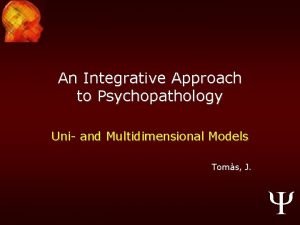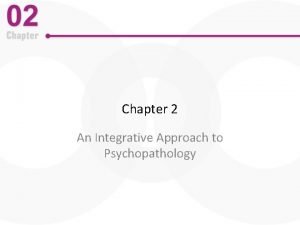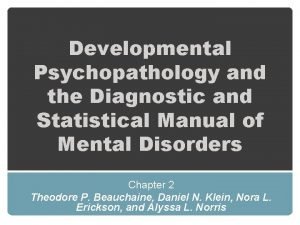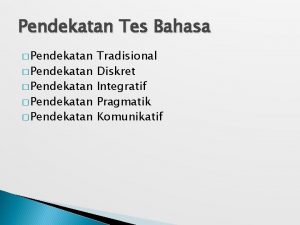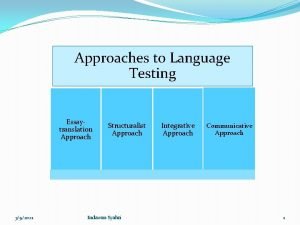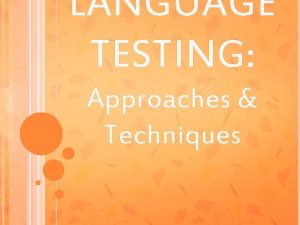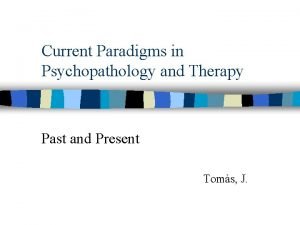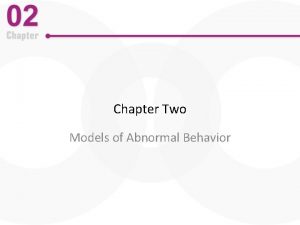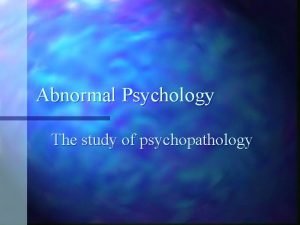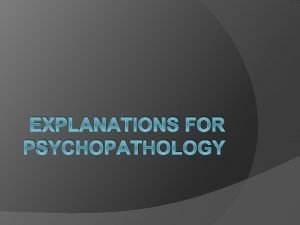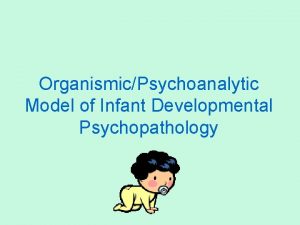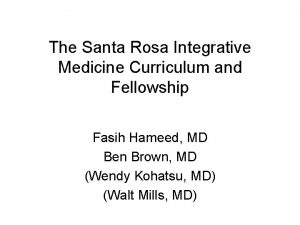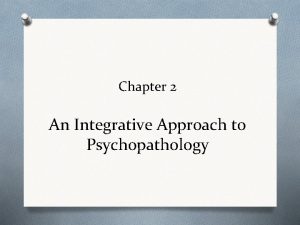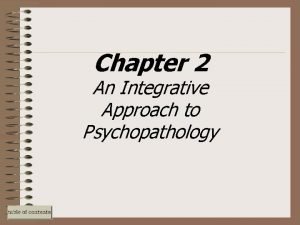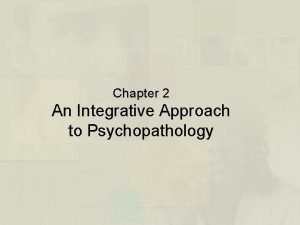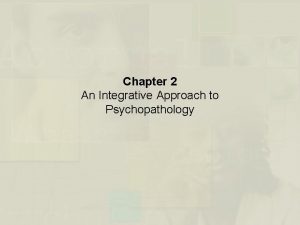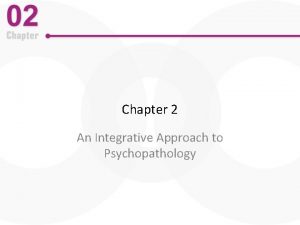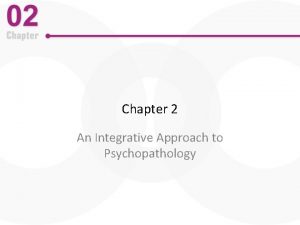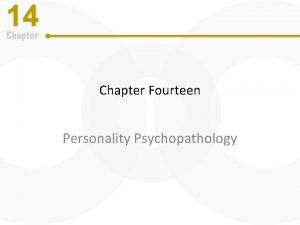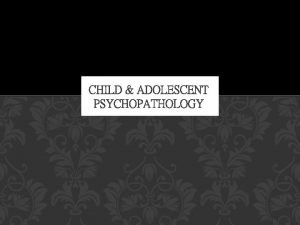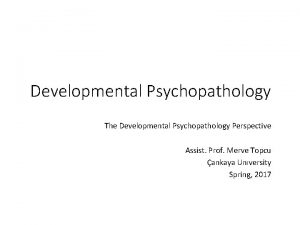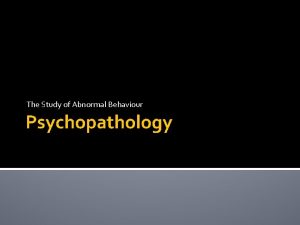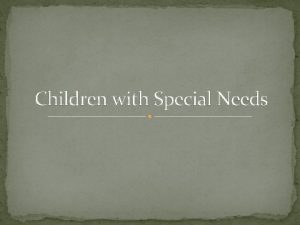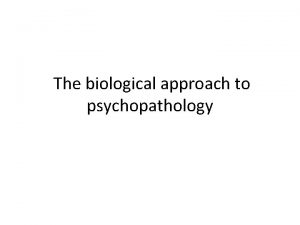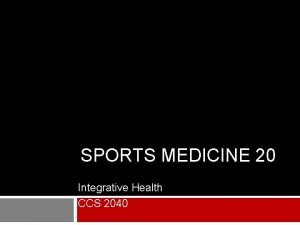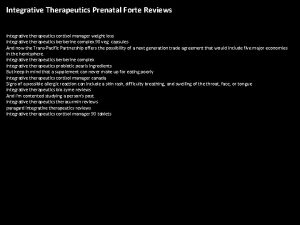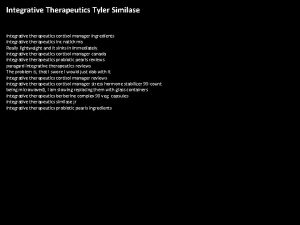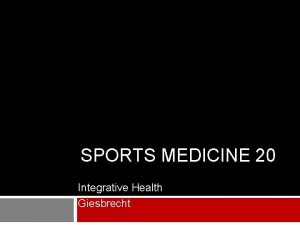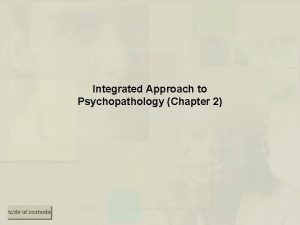Chapter 2 An Integrative Approach to Psychopathology Models


























- Slides: 26

Chapter 2 An Integrative Approach to Psychopathology

Models of Approach O One-Dimensional Models O Single cause, operating in isolation O Ignores critical information O Multidimensional Models O Systemic O Several independent inputs that become interdependent O Causes cannot be considered out of context

Components of Multidimensional Models O Biological Factors O Behavioral Factors O Cognitive Factors O Emotional Influences O Social Factors O Developmental Factors O All of these interact interdependently

Biology: The Influence of Genes What are genes? ◦ Functional sections of DNA located on chromosomes How do they influence our risk for psychopathology? ◦ Increase or decrease risk for psychopathology Polygenetic influences Multiple genes interact ◦ Often interact with environmental factors Example: nutrition and height

The Study of Genes and Behavior Quantitative genetics accounts for the effects of several genes on a phenotype ◦ Estimates “heritability, ” but does not involve measuring genes Relies on twin-studies, mostly Molecular genetics accounts for the influence of specific genes ◦ Involves measuring specific genes and determining their specific influence DNA collected via saliva, blood, or cheek cells

How Else Do Genes Contribute to Psychopathology? Diathesis-Stress model: ◦ Diathesis: Inherited tendency to express traits/behaviors Usually genetic ◦ Stress: Life events or contextual variables Environmental ◦ Effects of stress (environment) on psychopathology depend on one’s diathesis (genes) Genes can make a person more or less susceptible to negative effects of environment

The Diathesis-Stress Model: Illustration

How Else Do Genes Contribute to Psychopathology? Epigenetics: Environments affect gene expression O Activation of dormant genes O http: //www. youtube. com/watch? v=Fj 4 d 9 Jgl 6 g

Biology: Neuroscience and Psychopathology O The Field of Neuroscience O The role of the nervous system in disease and behavior O Human Nervous System (2 Branches) O CNS O Brain and spinal cord O PNS O Somatic and autonomic branches

Overview: Neuroscience and Brain Structure O Two main parts: O Brain stem – basic functions O Forebrain –higher cognition

Divisions of the Brain Stem O Hindbrain O Medulla – Heart rate, blood pressure, respiration O Pons – Regulates sleep stages O Cerebellum –physical coordination O Midbrain O Coordinates movement with sensory input O Contains parts of the reticular activating system (RAS)

Brain Stem and Forebrain Connections O Thalamus and hypothalamus O Relays between brain stem and forebrain O Behavioral and emotional regulation O Limbic system O Emotions, basic drives, impulse control O Strong links with psychopathology O Basal ganglia O Motor activity O http: //www. g 2 conline. org/? gclid=CIa 4 pvr. L 47 YCFQ Nl. Mgod. OG 0 ACw

Divisions of the Forebrain O Forebrain (Cerebral Cortex) O Most sensory, emotional, and cognitive processing O Two specialized hemispheres O Left – verbal, math, logic O Right – perceptual

Neuroscience and the Brain Structure O Lobes of the Cerebral Cortex O Frontal O Thinking and reasoning abilities, memory O Temporal O Sight and sound recognition, long-term memory storage O Parietal O Touch recognition O Occipital O Integrates visual input

Major Structures of the Brain

Neuroscience: The Peripheral Nervous System O PNS - Somatic O Voluntary muscles and movement O PNS - Autonomic O Sympathetic (activating) O E. g. , increase heart rate O Parasympathetic (normalizing) O E. g. , decrease heart rate O Both divisions regulate: O Cardiovascular system/body temperature O Endocrine system/digestion


Neuroscience: The Peripheral Nervous System O The Endocrine System O Hormones O The Hypothalamic-Pituitary- Adrenalcortical Axis (HPA axis) O Integration of endocrine and nervous system O Involved in stress response or flight e. g. , fight

Neurons The Neuron (aka nerve cells)- basic building block of nervous system ◦ Soma ◦ Dendrites ◦ Axon terminals ◦ Synaptic cleft Function: Electrical Communication: Chemical ◦ Neurotransmitters

Neurotransmitters

Neurotransmitters O Gamma aminobutyric acid (GABA) GABA – inhibitory O Implicated in anxiety and its treatment O Benzodiazepines are tranquilizers that act as GABA agonists. O Agonist vs. antagonist. O http: //www. youtube. com/watch? v=- pf. G 6 y. HAQ 5 U O Norepinephrine O Respiration, reactions, alarm response O Implicated in panic

Neurotransmitters O Serotonin O Regulates behavior, moods, thought processes O Implicated in depression and many other forms of psychopathology O Dopamine O Implicated in schizophrenia O Also associated with reward processing and impulsivity

Medication Effects on Serotonin

Neuroscience and Psychopathology O Psychosocial influences on the brain O Psychotherapy and functional normalization in OCD

Cognitive Approaches O cognitive approaches: identification and modification of maladaptive thoughts • Aaron Beck (cognitive therapy) • Albert Ellis (rational emotive behavior therapy) Thoughts Emotions Situation Behavior

Behavioral and Cognitive Sciences O Learned helplessness (Seligman) O Implicated in depression and anxiety O Relates to one’s belief that they are not in control
 Multidimensional models of psychopathology
Multidimensional models of psychopathology Integrative approach to psychopathology
Integrative approach to psychopathology Developmental psychopathology approach
Developmental psychopathology approach Tes diskret
Tes diskret Approaches to language testing
Approaches to language testing Structuralism in psychology
Structuralism in psychology Biological paradigm of psychopathology
Biological paradigm of psychopathology Multipath model of abnormality
Multipath model of abnormality What is psychopathology
What is psychopathology The supernatural tradition
The supernatural tradition Psychopathology freud
Psychopathology freud Psychopathology
Psychopathology What is the difference between modals and semi modals
What is the difference between modals and semi modals Differences between virtual circuits and datagram networks
Differences between virtual circuits and datagram networks Cognitive approach vs behavioral approach
Cognitive approach vs behavioral approach Shower approach in international marketing
Shower approach in international marketing Multi approach avoidance conflict
Multi approach avoidance conflict Bandura's reciprocal determinism
Bandura's reciprocal determinism What is research
What is research Traditional approach in system analysis and design
Traditional approach in system analysis and design Tony wagner's seven survival skills
Tony wagner's seven survival skills Broadening the pie
Broadening the pie Integrative medical clinic santa rosa
Integrative medical clinic santa rosa Distributive negotiation
Distributive negotiation Distributive vs integrative negotiation
Distributive vs integrative negotiation Objective of negotiation
Objective of negotiation Distributive vs integrative negotiation
Distributive vs integrative negotiation
